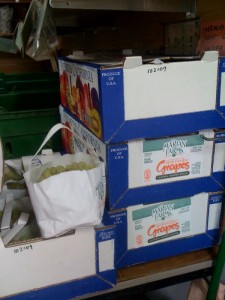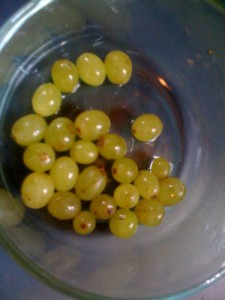Greening Your Gravesite: Halloween Edition of The Green Moms Carnival
With just a few days to go to Halloween, you might think that the @GreenMoms would be blogging about fair trade chocolate, trick or treat for Unicef, reverse trick or treating, or some other do-gooder topic.
But no. We’ve done all that.
To spice things up a bit this year, Deanna of Crunchy Chicken – the one who puts the “mental” in EnvironMental – suggested we blog about death. Green death, green burials, the green hereafter: whatever.
Heck, we’ve got Green Kids Movements, Green Nurseries, Green Weddings, Green Food, Green Fashion…why not Green Gravesites?
In fact, if you think about it – so much of going green is about going retro – back to the way our grandparents or great grandparents lived their lives.
Or, in this case, the way my grandfather, and his parents, and his parents’ parents, my great-aunts, great-uncles, cousins, and many more relatives ended their days in Bermuda.
Bermudian tradition calls for the deceased to be buried within 24 hours of death. This means there’s no need for embalming fluid, which typically contains toxins like formaldehyde.

Photo courtesy of Bulley-Graham Funeral Home, Bermuda
Native Bermuda cedar or mahogany (less common) are used to make the coffins, which are then placed in a family grave.
Here’s where things get really interesting, especially for us greenies.
Because the islands of Bermuda are made of limestone and coral, digging a grave is a difficult task – it was described as an “engineering feat” in this article from a 1921 edition of Popular Mechanics.

Why do all that work to dig just one grave?
The Bermudians are very practical people.
Instead, Bermudian families have family tombs into which they place deceased family members, one on top of the other. Well, not right away, anyway! You must wait a year before opening up a grave to bury another family member.
Over time, the cedar caskets decompose, making room for more family members. Unlike American cemeteries, which take up large plots of land, the Bermudian cemeteries are compact (like the island) and would never run out of land if operated according to tradition.
This arrangement worked well until Bermudians began moving abroad, which really began in earnest after the American Naval base was opened in the 1940s. American GIs left the island with Bermudian wives. Today, Bermudians leave to attend college abroad, and some never return home until their final visit. Then they return to the island embalmed, in a non-decomposing metal casket, which sometimes are so large it can be hard to fit the deceased into the traditional family plot.
So back to our carnival….thinking about my family traditions and Bermuda gave me this idea: Bermuda is known today as a destination wedding site. Wouldn’t it be amazing if Bermuda invented a “green destination burial” tradition too?
Of course, there’s probably a law against it.
And flying all those bodies in wouldn’t do much for the environment, either.

Aerial view of Bermuda Islands, courtesy of Wikipedia.org
But perhaps we could adapt some of these old Bermudian ways to our own burial traditions. I’ve always hated the sight of huge cemeteries – such a waste of land.
Care to start a family plot? I used to think of it as my family tradition. Now I think of it as a greener way to say good-bye.
Be sure to head over to Crunchy Chicken to check out the Green Moms Carnival – Greening the Dead – Halloween edition.
— Lynn
Copyright 2010 OrganicMania
Filed under Uncategorized | Wordpress Comments (7) |The Green Moms Carnival on 10-10-10
What are you doing today? Well, if you’re sitting behind your computer, head on over and check out the Green Moms Carnival on Climate Change, hosted by ClimateMama.
As for me, I’m home with a sicko – I knew it was bad when he was too weak to open a new Lego set that arrived in the mail. Of course, by 2 a.m. he was ready to play Legos again!
I’ve taken two long walks today, and sadly I don’t see any evidence of fewer cars on the road. It’s a gorgeous day, but it seems like just about any other day.
And you?
— Lynn
Filed under Uncategorized | Wordpress Comment (1) |Sunday is 10/10/10: What Are You Doing?
Apparently environmentalist Bill McKibbon wasn’t the only one to take early note of the significance of October 10, 2010.
The local merchants are full of promotions: Buy 10, Save $10 and Save 10% on 10/10/10 are among the most popular.
It’s a gorgeous weekend here in the Washington, DC region, with festivals, sports events and more going on.
But 10/10/10 is also expected to be the largest global action day in support of solutions to combat climate change. It’s part of a global campaign to reduce carbon emissions by 10% in a year – starting in 2010. As the organizers say, “Any person, family, business, school or other organization can cut 10% – and by working together we can make sure our actions count.” All over the world, people are registering “work parties” on sites including 1010global.org and 350.org.
I had high hopes to make it down to DC, where, as you can imagine, there’s a whole lot going on! But unfortunately my eldest fell ill today, so I won’t be going anywhere. I guess that’s very low carbon after all.
What are you doing?
If you don’t have any plans, check out these great ideas. One of my favorites is a low carbon Sunday brunch.
This is a post for the Green Moms Carnival on climate change, sponsored by our newest member, ClimateMama! Check out our posts which go up tomorrow over on the ClimateMama.com blog.
— Lynn
Filed under Uncategorized | Wordpress Comment (1) |Wednesdays at the CSA: Those Perfect Biodynamic Grapes! They’re Ugly!

Wednesdays are my favorite day of the week, because it’s “CSA Day.” The day when I pick up our weekly share of biodynamic surprises. We get whatever the farmers were able to harvest, and the abundance and variety is just one of the many special parts of belonging to our CSA.
A special note about the grapes in our share made me realize I was in for a very special treat.
“The special treat this week is GRAPES! They are small, green, Thomson grapes and are the same ones that produce the raisins we have in the CSA. Members from previous years will remember these grapes from last year at this time. We plan to offer them 3 times all together this year every other week, starting now.

What is special about these grapes? First, they are biodynamic and there is no other biodynamic farm in the country from which to get grapes. (only wineries). These grapes have no growth hormones, no shrinkage, no gibberillic acid which are used even on certified organic grapes and they are picked ripe and fresh to order. They should hold up a week or so refrigerated but
don’t take chances.”
Sure enough, they were out-of-this-world good, like so much of the food at the CSA. I still remember the first time I tried biodynamic produce – I felt like my pores and my bloodstream were literally opening up to receive the food.
I could have eaten them all myself, but being a “good Mother,” I wanted to make sure my boys got their share, so I dutifully gave up some of the grapes and packed them away in their school lunch.
When they returned home, I was disappointed to see that the grapes were largely untouched.
“I can’t eat them,” my 3-year-old told me. “They’re bad. They’re brown!”
It’s true…there were some brown spots.

“Honey,” I explained, “God made those grapes. They weren’t made by a machine in a factory, so they’re not all going to be the same. Some will have spots, each one will be unique, because each one is a part of nature.”
He wasn’t buying it.
His verbal skills aren’t advanced enough to construct an argument about how the Chilean grapes I purchase at the supermarket are uniformly glossy, round, and perfectly red….while these are…imperfect (at least to the naked eye).

My eight-year-old joined the argument. Forget biodynamics. He was sticking to the “perfect” (albeit less tasty) market grapes.
Have you ever noticed that what appears ugly on the outside can be beautiful on the inside? Not just a story of nursery rhymes or the human condition, but very much the story of real fruit and farm fresh veggies, straight from the garden – or the CSA.
Today was the last week we’ll be getting these amazing biodynamic grapes from the CSA. My kids aren’t eating them. But at least I don’t have to share them with anyone other than my husband!
— Lynn
Filed under Uncategorized | Wordpress Comment (0) |It May Be Bethesda Green, But You Can Come Even If You’re a Washingtonian
For two years now, I’ve been blogging about Bethesda Green. How it got started. The cool events we run. How amazing things happen when a community pulls together. And how I eventually moved my business there.
So can you indulge me one more time?
This Thursday evening, Bethesda Green has its first ever gala. Designed to – of course –raise money for the community sustainability non-profit, it will also honor a handful of amazing local businesses, non-profits, communities and people who are making a real difference in the local environment. I’ve had a sneak peek at the honorees, and trust me, they’re amazing! But you have to come Thursday to find out who exactly they are…I’m sworn to silence!
It’s guaranteed to be a lot of fun.
The last time I was out at a “green event” in DC, an eco-chic Washingtonian sidled up to me and said, “All the cool stuff is going on in Bethesda. Can people from DC come too?”
As I told her, “YES!!”
So if you’ve been wondering what we’re all about at Bethesda Green, now’s the time to find out. Buy your ticket here – NOW – before they’re all gone! And head on over to Imagination Stage on Thursday at 6 p.m.
I’ll be there…tweeting away, nose in my I-Phone. Oh, and I have a VERY LOUD laugh (just ask Green-Talk!) Please say hello!
— Lynn
Filed under Uncategorized | Wordpress Comment (0) |Green Moms Take On Sustainable Clothing: Eco-Chic or Eco-Challenged?
Head on over to Diane MacEachern’s Big Green Purse blog today, where you’ll find the latest edition of the Green Moms Carnival, this one devoted to the eco-impact of clothing.
And while in my post, below, I professed a love for Talbot’s, I don’t want you to think that I’m ALWAYS that conservative. I’m still smiling because of this tweet (with photo) from @juliepower aka @Moms2Work. She called me a “hot momma.” (So yes, as you can see, the diet is finally working a bit!)
— Lynn
Filed under Uncategorized | Wordpress Comments (3) |A Wonderful “Case Study” of My Tribe: The Amazing Women of the Green Moms Carnival
One might think that in my fourth “back-to-school” season, I’d have the drill down by now. But no.
Few posts lately as I’m still in “Green Mom Culture Shock” with the saga of the “mandated” Plastic Water Bottle yet unfolding. Today, for instance, Big Boy came home with a bottle of Nestle “Pure Life” flavored bottled water – part of the taxpayer subsidized school lunch program.
But rather than share another rant about the public schools (right now at least), I’m going to share with you a very interesting post written about the women who keep me sane and on The True Green Path: the wonderful women of The Green Moms Carnival. They don’t think it’s strange to avoid genetically modified foods, bottled water, plastic accoutrements, or a host of other things we greenish Moms view as all in a day’s eco-work. As many said in the comments on my “Plastic Water Bottle” post and off-line, they know what it’s like to be That Mom.
So please head on over to Geoff Livingston’s blog to read his case study which calls Green Moms Carnival “a great example of Fifth Estate civic engagement.”
Still not there? Ok, ok, I’ve got to share my quote from Geoff’s blog post.
“We have had employees of large multinationals approach us and thank us for our work, telling us that our demands for safer, greener, cleaner products makes it easier for them to get new innovations approved within their companies,” said Lynn Miller. “We’ve also had CEOs tell us that ours are the voices that are being listened to – that we are an important force for change. It would have been very easy to ‘sell out’ to commercial interests or even non-profit interests given all the interest in the ‘Mom space,’ but our stature as an independent alliance of top green bloggers enhances our credibility, our authenticity, and the uniqueness of our point of view.”
Now, go read the Case Study. And be sure to head on over to Diane MacEachern’s Big Green Purse on Monday, September 27th when she’ll host the September carnival on “Eco-Impact of Clothing.”
And if you’re like me – still struggling with Back to School adjustments – check out the August Carnival on “Back to School” hosted by Micaela of Mindful Momma.
Enjoy the weekend!
— Lynn
Copyright 2010 OrganicMania
Help a Fisherman Out: #CitizenGulf National Day of Action
What are you doing Wednesday night? If you happen to live in DC, San Francisco, L.A., Santa Monica, San Jose or any one of the 19 cities listed here, think about joining a Citizen Gulf meet-up to mark a National Day of Action to help Gulf fishermen and their families impacted by the Gulf Oil Spill Disaster.
Most importantly, you can kick in one of the $10 (or more) donations that are needed to raise $50,000 to help Gulf Coast fishing families recover from the disaster.
You may have heard that the Government has declared the Gulf waters open for fishing. (Kind of like they declared the air around Ground Zero safe to breathe. Remember that?) Many fishermen aren’t buying that line either…They haven’t gone back to work because they don’t want their kids or yours or mine to suffer the ill effects of eating seafood contaminated with the dispersants and oil that’s accumulated in the Gulf. (I still stick with what the experts at TedXOilSpill had to say on the matter, as I blogged here. Bottom line: no one knows the impact, and we won’t know for years).
Where will your money and time go? To efforts like the After School Assembly program run by Catholic Charities.
“After School Assembly has proven to be a family strengthener. When children are educated and cared for in a safe and no-cost environment, it reduces the stress of the parents and the stress on the family. Because we consider the oil spill to be an economic mental health crisis, we are trying to help families through many varied services.”
I just made my donation, and I’m sorry to report that the fund raising efforts aren’t exactly zooming along. Just four people have donated. Yes, I know it’s back-to-school time. (I saw the crowds tonight at the Bethesda Staples, where I was crowned “Mayor.”) Sure, you’re packing for a last minute beach vacation. But it takes 2 minutes …I timed it.
C’mon. Help out. Donate now.
Thanks!
— Lynn
Copyright 2010 OrganicMania
Filed under Uncategorized | Wordpress Comment (0) |@GreenMoms Take On Cosmetics: Safe or Unsafe? And Should We Support the Safe Cosmetics Act?: It’s the Green Moms Carnival!
We’ve got a wonderful round-up of posts from members of the Green Moms Carnival, women who have been following the debate about cosmetics ingredients for years, and have interesting stories to share.
Let’s start off with Diane MacEachern of Big Green Purse. Diane blogs “evidence is emerging that the cumulative use of these products may be contributing to asthma, the onset of puberty in girls as young as three years old, and even the feminization of baby boys. Because cosmetics, soaps and shampoos are washed down the drain, they get into our water system, where they’re wreaking havoc on wildlife. And what about their relationship to breast cancer?”
But Diane doesn’t leave us hanging – she gives three common-sense ways we can reduce our exposure to the potential risks of cumulative exposure to low doses of chemicals.
Beth Terry of Fake Plastic Fish tells the story of why she tried to get away from a cute seat mate on a recent flight. “His Axe cologne, or whatever heinous product he was wearing, made my eyes water, nose itch, throat close up, and left me with a throbbing headache.”
That’s something I’ve experienced as well. Once you stop using synthetic fragrances, it’s hard to even be around them. A walk down a grocery store aisle – or a whiff of last year’s BlogHer room drops – can leave you feeling miserable.
Lisa from Condo Blues recounts an interesting discussion with a research scientist from a personal care company.
“One of the biggest secrets about what chemicals (or not) is in a product is what makes up the product’s fragrance,” she notes. “Last summer, I had the chance to talk to a representative from a large personal care company. She claimed that even her company didn’t know what was in the fragrances of their products because they buy the fragrance from a special fragrance house that has a super secret formula and ironclad nondisclosure agreement that says the fragrance house won’t tell the company what’s in the signature scent of their brand of shampoo.”
Katy at Non-Toxic Kids makes a case for showing The Story of Cosmetics to friends who may be unfamiliar with the battle for safer cosmetics. As she puts it, “Why should you care? There is a growing body of research showing links between many of the chemicals in our personal care products and serious diseases and conditions. Chemicals like triclosan, phthalates, parabens are in most cosmetics. Phthalates are often labeled as “fragrance”. Triclosan is labeled as an “antibacterial.”
And no one is looking at their synergistic effect on our bodies, especially those who are developing and growing at rapid rates: our children. The companies who make these products are using many chemicals that have never been independently tested for safety. That’s right, never.”
Linda from Citizen Green presents a well researched post that follows-up on Katy’s assertion. As Linda blogs, “Only 11 percent of the 10,500 ingredients in personal care products have been assessed for safety by the cosmetics industry.”
And that’s the reason Deanna of Crunchy Chicken blogs, “Make sure you start checking your product labels!”
Karen of Best of Mother Earth pulls no punches when she asks, “How can cosmetic companies like Estee Lauder raise funds for cancer research and produce products with carcinogens in them? Shouldn’t they start in their own back yard and produce a safe cosmetic in the first place?”
I always especially enjoy the contributions of our Carnival members from outside the United States. In Amber’s post at Strocel.com, Story of Cosmetics: Canadian Edition, she blogs about the situation in Canada – how in some ways it parallels the situation in the US, and yet how there are subtle differences. For example, Canadian cosmetic makers are required to list ingredients – “but not all of them.” Huh? So what good does that do? But Amber’s main message is one that is universal:
“But we must recognize that the beauty industry is trying to sell us stuff, just like any other industry that markets consumer goods. They want us to believe that we are flawed and need their stuff. If we aren’t concerned about the state of our skin or the shininess of our hair, we’re not going to shell out for products to fix them. Even initiatives like the Dove Movement are marketing campaigns aimed to make us feel favourable towards a certain brand.
My daughter Hannah is 5 years old. I don’t want her to feel that she needs to coat herself with stuff to be OK, and I especially don’t want the stuff she coats herself with to contain toxins. That’s why I want to see change in the cosmetics industry.”
I always see myself in Micaela’s (aka Mindful Momma’s) posts. Maybe it’s because we have kids around the same age, and while we are passionately committed to living sustainably, too often our lives intersect with the real world of Toys R Us and Pokemon.
In her post, “Maybe I Just Bought the Wrong Stuff,” Micaela blogs, “In The Story of Cosmetics, Annie Leonard comes out and says what a lot of us might be thinking when it comes to buying cosmetics and personal care products: “maybe it’s my fault…maybe I just bought the wrong thing”…meaning it’s our own damn fault for buying personal care products loaded with toxins and petroleum products…because we didn’t take the time to research the hell out of them before we went to the store.
I’m telling you – that is often how I feel. And it’s very frustrating.”
Frustrating? Lisa from Retro Housewife Goes Green goes even farther when she blogs, “I don’t know about you but I’m pissed off at the amount of work I have to do to keep myself and my family safe from cancer causing chemicals. We need to change the whole system and work together to demand safer cosmetics.”
I’m with Lisa – the whole system needs to change, and in my opinion, that includes regulation. But I’m not so sure the Safe Cosmetics Act is the answer. Check my post out here, where I blog about what I’ve learned in two years of following these issues – the things people inside the industry have told me – and my surprise and concern about the backlash opposition to the Safe Cosmetics Act that is being led by small, independent cosmetics makers.
Jennifer Taggert of The Smart Mama (and an attorney) voices her concern that the Safe Cosmetics Act may mean for small businesses. Jennifer has a unique take on this, and her full post is worth a close read. Here’s an excerpt:
“I bring the CPSIA up after watching The Story of Cosmetics because well intentioned legislation can go badly wrong.
That doesn’t mean that I don’t urge you to understand what it is you are buying. To adopt the precautionary principle in your purchasing decisions.
That doesn’t mean that I don’t think we should advocate for sensible legislation and regulations.
But that’s it – the legislation and/or regulations must be sensible. And that is hard to do. The devil is in the details. Overbroad legislation has unintended consequences and collateral damage.
As said by Supreme Court Justice Louis Brandeis:
The greatest dangers to liberty lurk in insidious encroachment by men of zeal, well-meaning but without understanding.”
What do you think?
Leave a comment and let us know!
And did you know you can get ALL of our posts pushed out to you via Twitter? Just follow us here: http://www.twitter.com/GreenMoms
— Lynn
Copyright 2010 OrganicMania
My Story of Stuff: The Stuff Industry Insiders Have Told me About the Battle over Safe Cosmetics
For two years I’ve been blogging about whether we really need government regulation of the chemicals commonly used in both personal care products and household care products.
I’ve not just been blogging, as I’ve shared here, but asking questions of just about everyone I’ve come across who has a connection to the chemicals and personal care industries.
I first went directly to the source. But Johnson & Johnson – who spends millions “courting bloggers” according to this Ad Age article – wouldn’t answer my questions about chemicals reform – even after a phone conversation, email, and a blog post. (Maybe they’ll answer my questions next week, when I see them at BlogHer).
And the industry council, The Personal Care Products Council? They wouldn’t talk either.
So I asked a professor of environmental science about the issue. “It’s bad,” she said. “Really bad. Nobody really knows what the impact is of all these chemicals.”
I stood up at the annual meeting of the Soap and Detergent Association and asked my questions. All I got in return was a bunch of non-answers from a lawyer who was clearly trying to evade the issue. It was frustrating, and it caused my skepticism to grow.
I asked the chemicals industry consultant who sat across the aisle from me on a long plane ride. Just like the professor, he acknowledged that the industry really doesn’t know the cumulative impact, but it didn’t look good. They could go with other chemicals, but they’re more expensive and it’s a cumbersome process to change.
“Why don’t they resolve it within the industry and avoid regulation?” I asked. “The regulatory process is just a waste of tax payer money. Industry could do a better job of fixing the problem anyway than via government oversight.”
“I tried to get them to do that,” he said. “But they’re afraid of litigation. If one company admits that there’s a problem with their ingredients, the lawyers will come after them.”
Here was a guy who was clearly frustrated – and disgusted.
The fact is, there’s no incentive to find out what the cumulative impact is of repetitive exposure to everyday chemicals. There’s disincentive.
The introduction of the Safe Chemicals Act purports to change that. Its supporters tied the launch to the debut of a controversial new video by Annie Leonard of “Story of Stuff” Legend. In just 10 days, it’s already racked up nearly 200,000 views.
But just like the truth, the stories I’ve been told are not all one-sided.
There was the brilliant toxicologist who spent 30 minutes with me, discussing the issues in the clear, straightforward way that is common to really bright people who can distill an issue down to its simplest elements.
He denied that his company made one version of product for sale in the EU, where chemical laws are tougher, and a different version in the US.
He also railed against the EWG, saying that their database distorts science and scares people (essentially the same arguments the formaldehyde lobby made on my blog, but stated in a much nicer way!)
And he’s not the only one. Quietly, even organic and natural beauty advocates say the same thing.
Has the EWG stretched their case to make a point? Perhaps.
But would we have come this close to having government re-examine the safety of our everyday products were it not for the efforts of the EWG? Of course not.
Just five days ago, a rebuttal was posted to The Story of Cosmetics. Far from 200,000 views, The Critique of The Story of Cosmetics has attracted just 12,750 views. But of course I watched it just to see if it answers my questions.
It didn’t. Never does the critic address the central issue at stake: what is the impact of the cumulative exposure of these chemicals?
I read the response issued by the Personal Care Products Council to the Annie Leonard Film. It doesn’t address the issue either.
And now I feel confident I know why.
They just don’t know.
It’s not how business works. Each company is worried about its own products – not the interaction of their products with others.
So what can a consumer do?
1. Use fewer personal care products, particularly if you’re pregnant or someone who may wish to become pregnant (or impregnate someone! – yes, chemicals like phthlates have been linked to decreased sperm count). Avoid personal care products for infants and young children.
2. Consider products that can be used for more than one purpose. (Guess what? Most of the “special uses” are all about marketing anyway!)
3. Think organic and natural (yes, I realize they contain chemicals, but not the types of chemicals that are linked to hormone disruption).
It’s all very confusing. And to make things even more so, a coalition of independent cosmetics makers (you know, the sweet ladies who sell natural and organic make-up on Etsy and at the local fair) have come out in opposition to the Safe Cosmetics Act. They’re concerned that the bill’s requirements will put them out of business. While the supporters of the SCA dispute that, it’s easy to sympathize with these women. After all, it wasn’t long ago that the government made a mess of CSPIA legislation, driving similar small businesses (consignment shops and the like) out of business.
Thanks for reading this far! A long post I know, and without all the links, which I’ll add in shortly!
I want to hear your thoughts as well. What do you think about the debate over cosmetics and the SCA?
This post is for the Green Moms Carnival on Cosmetics, to be hosted here at OrganicMania.
— Lynn
Copyright OrganicMania 2010
Filed under Uncategorized | Wordpress Comments (13) | My StumbleUpon Page
My StumbleUpon Page



